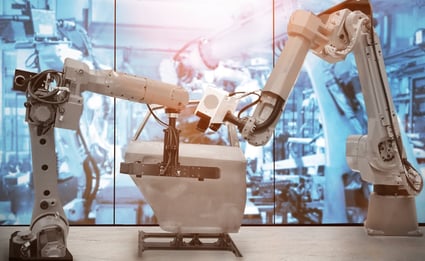How Automakers Can Reduce Internal IT Costs
Brian Hoey - October 20, 2020

Just a few years ago, a PWC survey found that cost reduction was one of the top three concerns at global manufacturing companies. Those companies were undertaking a host of different strategies to manage costs across the board—from operationalizing lean manufacturing, to driving efficiency improvements through automation, to moving towards smarter supply chain management. In the intervening three years, cost pressures across the industrial sector have shown no signs of abating. As Deloitte points out, cost volatility was a major issue for manufacturers even before the advent of the coronavirus crisis.
Deloitte goes on to note that one of the top strategies for thriving in this business climate is to “build digital muscle.” This means integrating things like AI, advanced analytics, and other supply chain technologies into your planning and execution processes. Without a doubt, these can be a great way to build up a competitive advantage—but there are also a number of potential pitfalls that manufacturers need to avoid if they actually hope to realize cost savings. No technology is a panacea, but the right IT can be a huge boon to your bottom line if you implement it in a smart, integrated way. Conversely, a technology deployment that goes awry can have the opposite effect. The question is: how do you make sure your IT spending doesn’t put you in the latter category?
What Drives up IT Costs for Car and Truck Manufacturers?
To understand the right way to reduce internal IT costs—and potentially use that IT to power additional cost savings elsewhere on the value chain—we first need to go over the factors that contribute to high IT costs in the first place. If you’re hosting your IT internally, your costs come from a lot more than just software licenses: not only do you need to shell out for servers, you also need to factor in costs for server maintenance and replacement (servers and other hardware really ought to be changed out every few years), physical storage space, and staffing costs for installation and ongoing maintenance—including updates and future integrations.
None of this needs to be a deal breaker, especially if you’ve positioned yourself to reap cost-cutting rewards from your IT in an efficient way. Unfortunately, this is easier said than done. In point of fact, centralized software deployments can present manufacturers with a handful of hidden costs on top of the ones we sketched out above. If you’re employing any legacy solutions, for instance, you could easily find yourself stuck in a position where you need to get some redundant software solution to cover functionality that the original solution doesn’t provide any more. In a similar vein, if the centralized nature of your deployments causes issues with visibility or with supply chain integration (either because production planners at remote plants can’t access the data they need when they need it, for instance, or because your supply chain partners aren’t able to share information without some shared IT), you’ll potentially end up with a mix of redundant software (e.g. at multiple plants) or disruptions that could have been prevented by improved visibility.
The Cost-Saving Potential of the Cloud
The cloud isn’t the only way forward for solving these issues and managing costs—but it is in many ways the easiest. Not only do you trade the costs associated with server upkeep and maintenance for the frequently much-lower costs associated with a SaaS, you can also reap cost-saving benefits from the mere fact of having heterogenous, decentralized solutions powering your business processes. If we take monolithic modern ERP solutions as an example of a centralized and homogenous way to manage IT, a number of potential pitfalls become clear. Specifically, we can see the ways in which, historically, this has led to extremely rigid software deployments that lack the flexibility required for effective production, sales, and logistics planning. The end result is lots of shadow IT, resulting in poor visibility and minimal cross-functional collaboration, and potentially large scale disruptions.
The cloud, by contrast, can power decentralized and heterogenous solutions that have the exact opposite effect: visibility is high because users can access data in real-time, perform planning processes in collaborative environments, and integrate their needed functionality into existing systems without resorting to shadow IT. This, in turn, gives you the flexibility to perform smarter planning flows across the board. Rather than shelling out for premium freight on a particular shipment because your production and logistics planning didn’t have access to the same information, you can coordinate through series of cloud-based apps that interwork seamlessly, identify your transport demands in advance, and take appropriate steps to secure capacity at the right price.
Powering Digital Transformation
Obviously, the example we gave above represents just one circumstance in which a distributed, cloud-based system can power cost optimizations in planning workflows—all above and beyond the cost optimizations (of up to 30%) realized in your actual internal IT budget. There are plenty of similar scenarios where the same sorts of cost savings can be achieved, from real-time production planning that benefits from lower latency when tracking information across different plants, to transportation forecasting powered by cloud-based analytics. Generally speaking, these scenarios revolve around a similar theme: digital transformation. By establishing a network of interconnected planning applications—from cloud-based ERP systems to decentralized TMS, scheduling, and slotting solutions—you can set yourself up for a successful digital transformation and even Industry 4.0 adoption.
What will this look like in practice? For starters, real-time connectivity up and down the value chain will make it possible to constantly ingest and analyze an obscene number of data points. Based on that data, you can create demand predictions and transportation forecasts that enable you to tailor your production and transport planning to emerging market situations—thereby avoiding shortages, outages, delays, and premium freight costs. On top of that, you can use AI and advanced analytics to constantly optimize your production and transport network, and even incorporate some autonomous workflows, e.g. smart warehousing operations that can place resupply orders without human intervention when inventory gets too low. The potential here goes well beyond that of reduced internal IT costs—but those reduced costs offer an exciting start and some quick wins when it comes to grappling with cost volatility in modern automotive supply chain.
If you want to learn more, download your guide to Transformation of Manufacturing Processes.
In this Guide you will learn:
-
Emerging Challenges in the Modern Truck/Automotive Industry
-
How Can Global Companies Adapt to These New Realities
-
How Decentralized Digital Systems Power Smarter Planning Processes
-
How flexis Can Support Flexible Supply Chain Transformation
LATEST POSTS
- Understand Circular Economy in The Manufacturing Industry
- How Can Industry 4.0 IT Integration Be Achieved Smoothly?
- The Significance of Order Sequencing in Discrete Manufacturing
- How to improve your Supply Chain Management: The Power of Control Towers
- Optimizing Human Resource Scheduling in Manufacturing: A Technological Approach


